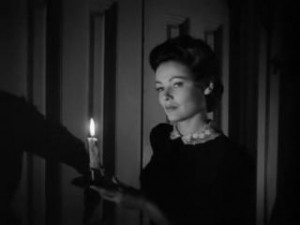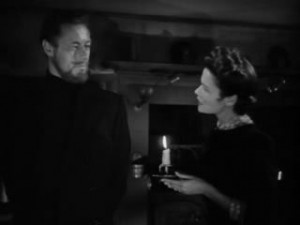 Shortly thereafter, Lucy decides to surprise Fairley at his residence and is surprised herself to meet his wife. Now she is left to spend the rest of her life at Gull Cottage, along with Martha, for her daughter (now Vanessa Brown) has grown up with children of her own. Of course, the end is perhaps predictable: When the elderly Lucy dies, Captain Gregg returns and, together, they pass through the doors of the balcony that overlooks the sea into eternity.
Shortly thereafter, Lucy decides to surprise Fairley at his residence and is surprised herself to meet his wife. Now she is left to spend the rest of her life at Gull Cottage, along with Martha, for her daughter (now Vanessa Brown) has grown up with children of her own. Of course, the end is perhaps predictable: When the elderly Lucy dies, Captain Gregg returns and, together, they pass through the doors of the balcony that overlooks the sea into eternity.
Too tame and subtle for most of today’s audiences, and not a financial success when it was released, The Ghost and Mrs. Muir is nevertheless an achievement in all aspects. It is, in fact, one of those rare movies, even in Hollywood’s Golden Age—well, anyway, in one of the years of its warm afterglow—when all the ingredients that make a movie memorable serendipitously come together. Joseph L. Mankiewicz, not always the most even of directors—take Suddenly Last Summer and Cleopatra (1963)—got it together this time with a light touch, a blend of restraint and understatement.
And Herrmann’s score? Like his music for Psycho, here is a rare case where the music definitely, and crucially, adds dramatically to the visuals and to the story, and to ignore the music is to miss one of the rewards of the film. Make a point, please, to listen! The restrained, low-key atmosphere of the film is reflected throughout by the composer’s now atmospheric, now romantic, now impressionistic music. (Excerpts from three-quarters of the score, originally released on LP in 1975 by the Elmer Bernstein Film Music Collection with Bernstein conducting a London orchestra and reissued on CD by Varese Sarabande, remain the definitive version.)
In keeping with the non-supernatural showing of Captain Gregg, Herrmann abstains from use of the theremin, the conventional instrument of ghosts and the eerie. This is, after all, not a fright, certainly not a horror, movie; it is a fantasy, a love story, albeit a mystical one. (The camera is likewise handled in a conventional manner by the perennially Oscar-nominated Charles Lang, who, by the way, was nominated, unsuccessfully, for Black and White Cinematography for the film.)
Those familiar with Herrmann’s style will note an almost uncharacteristically subtle and melodic score, though most of his music has its lyrical moments! Yes, with a standard orchestra, including two trumpets, four horns, three trombones and a tuba, the makeup is much different from his sometimes audacious instrumentation, where he augments to reflect the drama and visuals of a given film, i.e., the electronic instruments in The Day the Earth Stood Still, the strings only in Psycho or the five organs, winds, percussion, numerous harps and no strings in Journey to the Center of the Earth.
The main title of The Ghost and Mrs. Muir, which immediately sets a sea mood, comprises three themes: the ascending series of sixteenth notes representing the sea, a song-like tune associated with the cottage/the ghost and a lyrical tune full of sharped notes to symbolize Lucy.
Possible “disruptions” in the generally subdued score appear in the jaunty, chugging music for the train Lucy takes to and from London and for a storm, though both are, for Herrmann, surprisingly low-key, the light and transparent scoring maintained despite all that brass. As in all of his scores, Herrmann did his own orchestration.
Some critics—and ordinary music lovers—have seen this music as variously reflecting Debussy’s La Mer, Wagner’s Die fliegende Holländer or Britten’s Peter Grimes. The first two are generally too strong and dramatic, the third too modern-sounding and irregularly metered; the Ghost score is more like the quieter moments in Elgar’s Sea Pictures, Chausson’s Poem of Love and the Sea, the vocal parts in each notwithstanding, or another Debussy work, the atmosphere-drenched Prelude to the Afternoon of a Faun, which has nothing to do with the sea but with a mythological creature.
 Rex Harrison’s career after The Ghost and Mrs. Muir would generally depart from the light, English drawing room films, which, to a degree, had typecast him, although the genre would persist in The Fourposter, Unfaithfully Yours, The Constant Husband and others. His talent was often diluted, or misdirected, during the 1960s vogue for spectaculars, in the likes of Cleopatra, The Yellow Rolls-Royce, The Agony and the Ecstasy and Doctor Dolittle. Other later films—Crossed Swords (1978) and A Flea in Her Ear—were out-and-out insults, examples of the almost predictable decline of material in stars’ latter careers.
Rex Harrison’s career after The Ghost and Mrs. Muir would generally depart from the light, English drawing room films, which, to a degree, had typecast him, although the genre would persist in The Fourposter, Unfaithfully Yours, The Constant Husband and others. His talent was often diluted, or misdirected, during the 1960s vogue for spectaculars, in the likes of Cleopatra, The Yellow Rolls-Royce, The Agony and the Ecstasy and Doctor Dolittle. Other later films—Crossed Swords (1978) and A Flea in Her Ear—were out-and-out insults, examples of the almost predictable decline of material in stars’ latter careers.
Some seventeen years before his retirement, however, he would reach his peak—and win an Oscar—for Professor Higgins in My Fair Lady. And it would be another English drawing room story, and, to boot, one written by the familiar George Bernard Shaw.